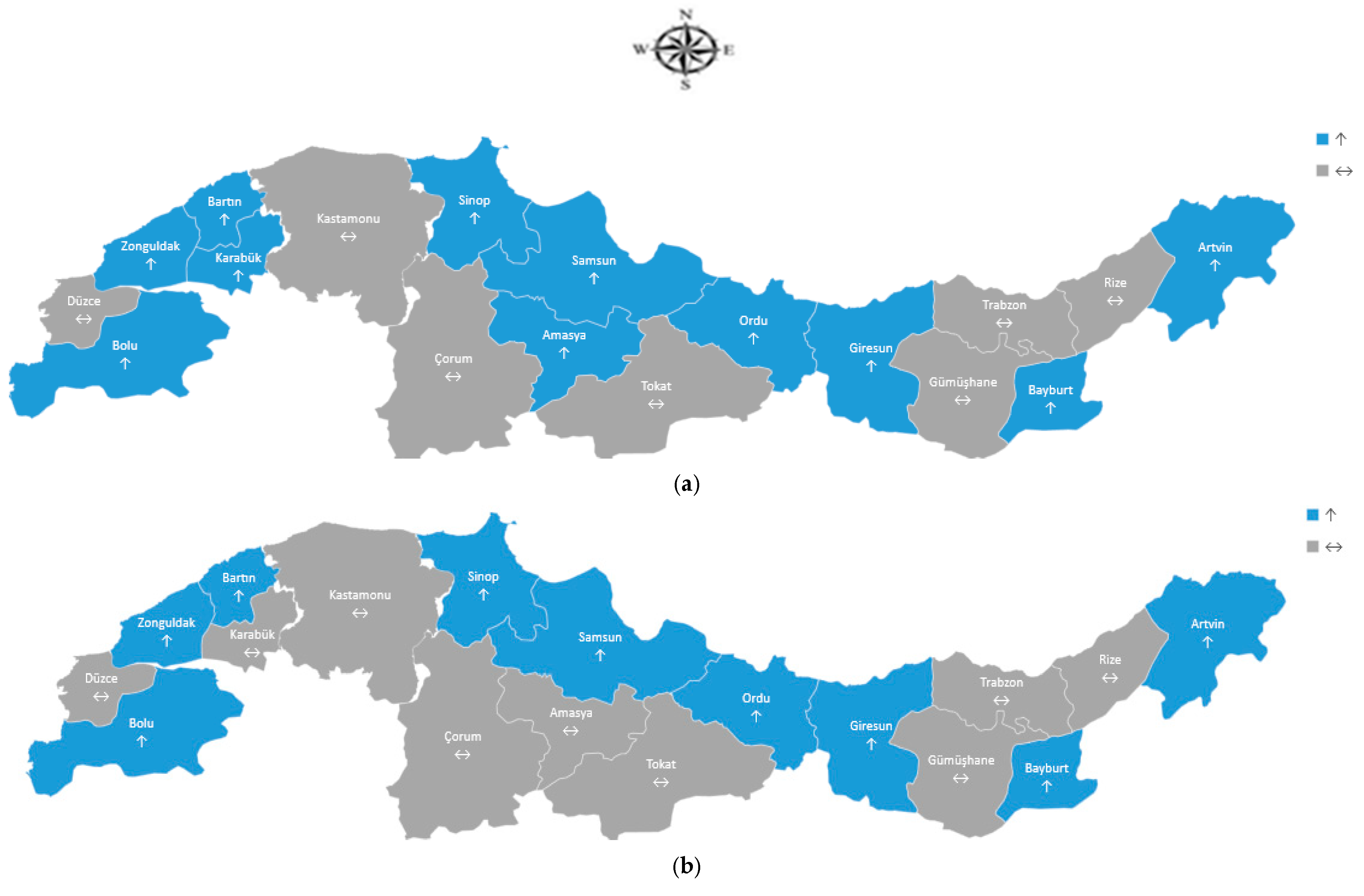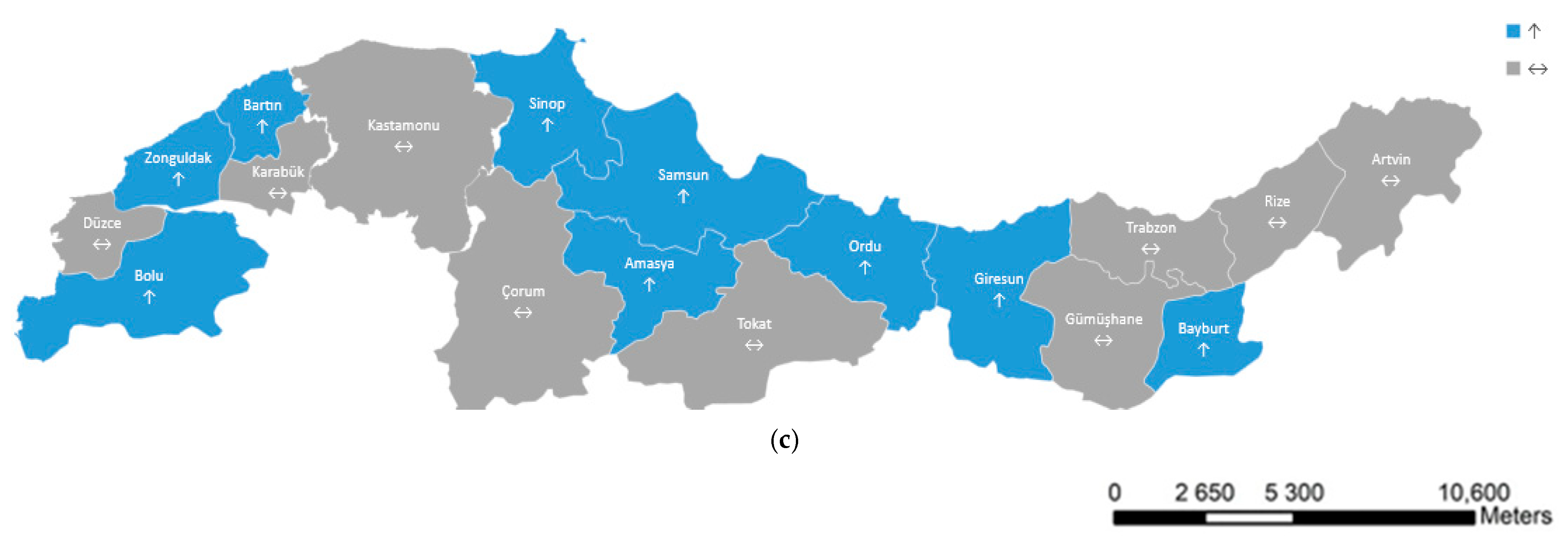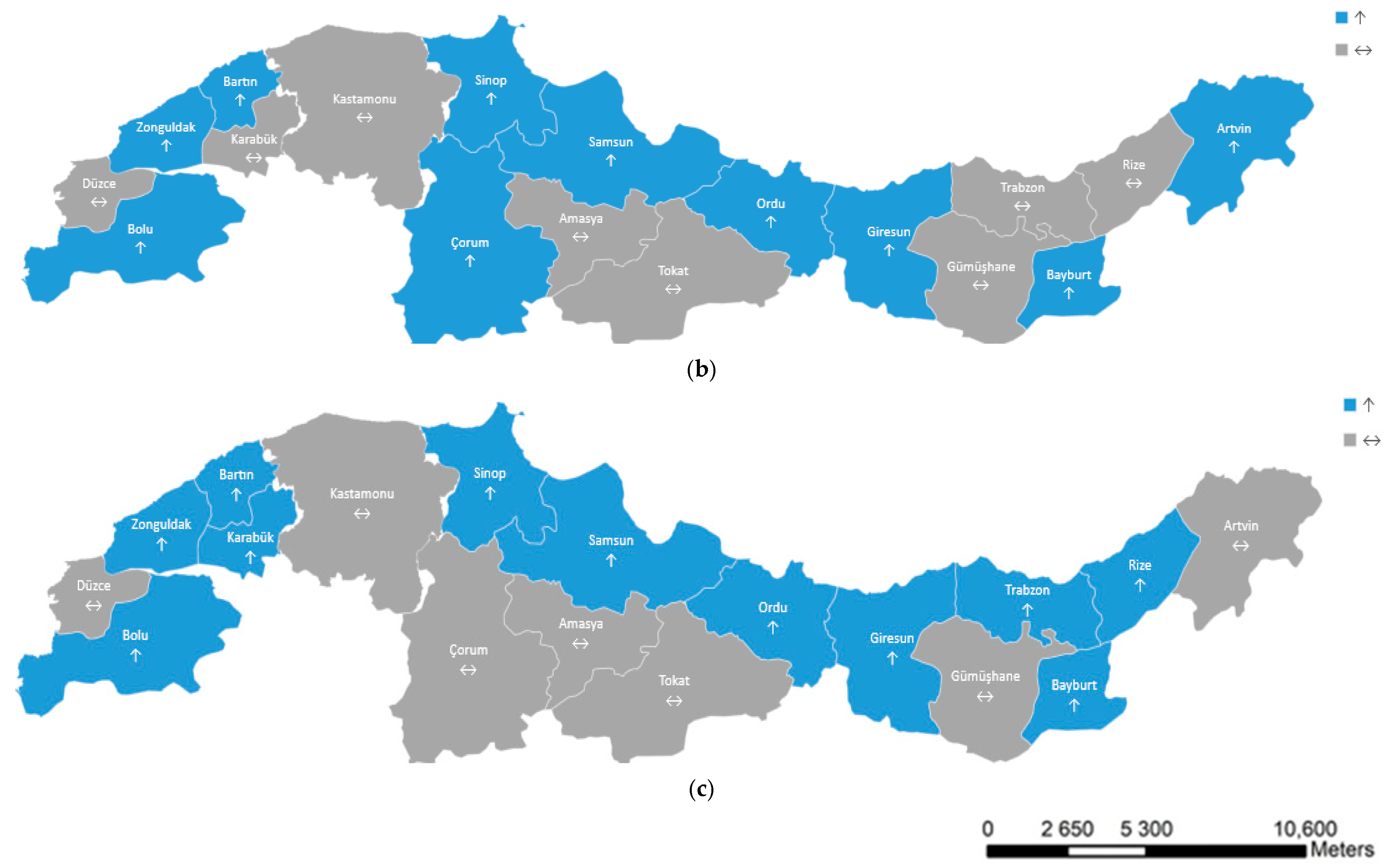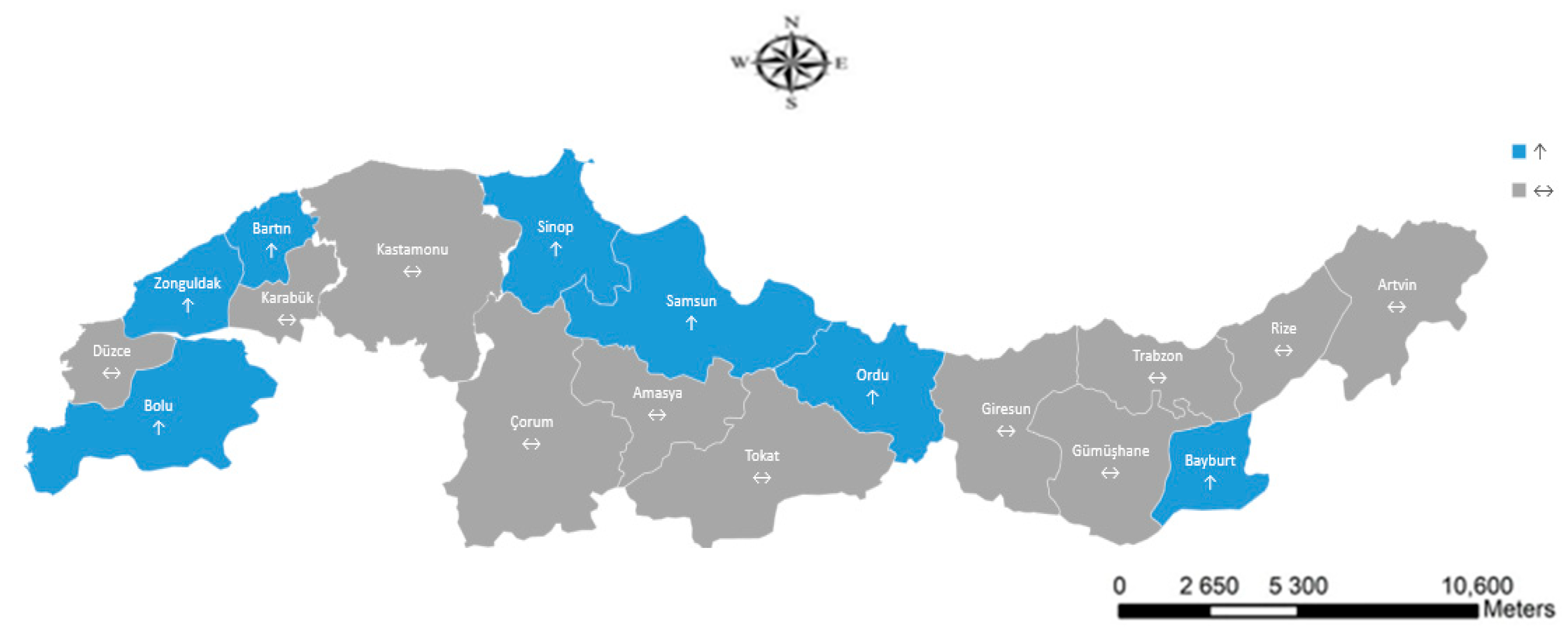1. Introduction
As a result of agricultural and industrial developments, there is an increase in the demand for water. This situation reveals the importance of studies on water consumption, water management, and irrigation practices. Irrigated agriculture contributes substantially to global food production. When the total cultivated agricultural land in the world and the irrigated lands are compared, it can be seen that less than 20% of the total area is irrigated agriculture. On the other hand, around 40% of the world’s food needs are met in regions where irrigated agriculture is practiced [
1].
The amount of evapotranspiration, which is closely related to irrigation and agricultural production, is the actual amount of water consumed by plants. In this respect, ensuring sustainability in agricultural production is possible by determining the evapotranspiration amounts appropriately. Evapotranspiration (ET) is defined as the total amount of water lost through evaporation on the soil surface and transpiration from plant material [
2]. Based on the importance of evapotranspiration values, regional evapotranspiration maps have been prepared for sustainable agriculture and especially for proper water management [
3,
4,
5]. In addition, irrigation applications can be planned with qualitative and quantitative methods. The method that individuals often use personally is to observe the grass and irrigate when yellowing or drying occurs. However, plant losses may occur with this type of planning. In terms of irrigation planning, it is more appropriate to make measurements with the help of evaporation loss calculations [
6].
As a result of the water cycle, a large amount of water falling on the earth as a result of precipitation returns to the atmosphere by evapotranspiration in plants. Evapotranspiration, which is important in many different aspects from a hydrological point of view, is a difficult process to determine precisely and clearly. It is necessary to know about evapotranspiration in many types of research, such as irrigation management and planning, sustainability of water resources, drainage practices, drought analysis, groundwater studies, and environmental analysis. The calculation of evapotranspiration is not only important in arid regions but also in humid regions in summer, and as a result of climate change, it has critical importance in terms of decreasing water resources. However, an accurate evapotranspiration calculation is of great importance for irrigated agricultural activities and hydrological basins in humid regions. Methods such as the water balance method [
7] and the water vapor mass flow transfer method [
8] in evapotranspiration determination make calculations that are costly and take a great deal of time. In addition to these methods, there are reference evapotranspiration calculation methods that require less time and cost [
9].
Estimation of reference evapotranspiration (ET
0) in terms of agricultural production is frequently used in irrigation management applications. In this context, vegetative irrigation needs can be estimated for future periods [
10]. Many methods have been developed to determine ET
0. When a lot of data are required in the developed methods, it is often difficult to obtain the required data correctly. In this context, empirical methods have been developed to calculate reference evapotranspiration with a small amount of data and cost. Some of these methods, namely Blaney–Criddle (BC), Turc (TR), and Coutagne (CT) methods, which are measured according to air temperature values, allow ET
0 measurements with temperature and precipitation data [
11,
12,
13,
14].
In many studies, BC, TR, and CT techniques have been used for estimating ET
0 in different regions [
15,
16,
17]. It has been emphasized that these techniques provide results with few data. For example, the BC method came to the forefront in determining ET
0 values in the Mediterranean region [
18]. Similarly, the correct results of the differentiated BC method were determined [
19,
20]. On the other hand, the TR method came to the fore in the research conducted in the USA and India [
21,
22,
23,
24]. In a study conducted in Italy, TR and CT methods were used together, and correct results were obtained with both methods [
25].
Trend analysis is applied in the interpretation and prediction of many hydrological events such as ET
0 calculations. Although there are many methods developed for trend analysis, the trend is usually determined by more than one method. The most commonly used method among these methods is Mann–Kendall (MK). The MK Test is widely used to detect the existence of a statistically significant trend, especially in a hydrological time series [
26,
27]. It is a linearly fitted, nonparametric model and does not require any hypothesis about the distribution of variables [
28]. The MK method has been used for ET
0 trend analysis in many other studies in China, India, the USA, and globally [
29,
30,
31,
32,
33,
34,
35].
Another method used to determine the trend of ET
0 calculations, innovative trend analysis (ITA), has been used in many studies. For example, in a study conducted in Malaysia, the trend of ET
0 data was determined by the ITA [
36]. Similarly, [
37,
38,
39,
40] used the ITA in their trend studies. In a different study, Sen’s slope (SS) was used to determine the trend of the reference evapotranspiration values of the Western Himalayan region [
41]. In a similar way, results were reached with Sen’s slope in different conducted studies [
42,
43,
44,
45,
46]. In a different study conducted in Brazil, the Spearman’s rho method was used for the ET
0 trend [
47]. However, in different conducted research, trend study was conducted with the Spearman’s rho in a similar way [
48,
49,
50].
In this study, we aimed to determine irrigation requirement and especially ET0, which is one of the most important parameters of the hydrological cycle, with quantitative empirical methods as an important guide for national and international studies to be carried out for water management, irrigation planning, and basin-based approaches in the future. For this purpose, according to the 12-month ET0 values determined by three different methods of the provinces in the region, the trends in the future periods were revealed with MK, ITA, SR, and SS trend tests from 1965 to 2023. The innovation brought by the different approach in the research is that instead of reaching the result with one or two trend tests and a single ET0 determination method, the trends found in common in three different ET0 calculation methods and four different trend test results are taken into consideration. In addition, the ET0 trend of the entire Black Sea region was determined instead of a subunit of a province or region. In this context, the research was carried out with the aim of determining more comprehensive and accurate trends.
4. Discussion
Calculation of ET
0 values according to time series and estimation according to trend analysis have come to the forefront as an effective method, especially since they can better determine more complex patterns in the data [
85]. In the study, it was observed that an increase occurred mainly in ET
0 values. In a study conducted in the eastern provinces of the Black Sea region, a trend analysis was conducted in terms of drought in terms of temperature, precipitation, evaporation, and wind conditions between the years 1960 and 2016 with a 95% confidence interval [
86]. According to the results of the study, it was concluded that evaporation increased in the province of Trabzon in the eastern Black Sea region. Similarly, according to ITA, SS, and SR trend analyses in the study, an increase was experienced in the current provinces. In addition, since more trend-testing methods were used in the study, it was observed that different provinces in the region tended to increase more comprehensively.
In another study conducted in the Black Sea region, the authors attempted to reveal the drought trend using different hydrological models according to data from 1973 to 2006 [
87]. The results of the study are similar to that of the present research and indicated that drought values are increasing. Similarly, in a different study, the evapotranspiration trend for future periods was revealed using MK, SS, ITA, and SR tests in Bayburt and Gümüşhane Provinces in the eastern Black Sea region between 1965 and 2018 [
88]. Although the results of the study are generally similar to that of the present research, they indicated an increase in drought. In a study conducted in the western Black Sea region, a trend analysis was conducted in order to reveal the drought trends of the region. In the study, the trend tendency of rainfall and flow conditions was revealed using MK, ITA, SS, and SR tests. According to the results of the study, it was concluded that there was a decrease in rainfall and flow conditions and that drought was increasing [
89]. In general, the studies conducted in the Black Sea region were conducted regionally, namely in the western, central, or eastern Black Sea regions, unlike the present study, which covered the entire western, central, and eastern Black Sea region.
In another study, trend analysis was conducted in Iran between 1965 and 2005 according to ET
0 values, and MK and SR tests were used [
31]. Similarly, in the ET
0 trend analysis study conducted in the Marmara region, the trend in the region was determined using MK and SS tests [
90]. The conducted studies gave consistent results at a 5% significance level, as confirmed by the research, between MK and SR tests. In another study, ET
0 trend analysis was conducted in the Punjab region of India between 1980 and 2021 [
37]. In the study results, the ITA and SS trend analyses showed similar values. Although there were differences in some provinces in ITA and SS trend values within the scope of the study, similar results were obtained. When the studies were evaluated, it was seen that the trend tests used were generally two different tests, e.g., MK-ITA, ITA-SR, or MK-SS. In the study, the use of MK, ITA, SS, and SR tests in a more comprehensive manner allowed the trend to be revealed in more detail. In addition, differences between trend methods were obtained in this way.
In Turkey, from the point of view of evapotranspiration values in the Konya region, especially under the BC method, there was an increasing trend, and differentiation was a good alternative [
91]. According to the results, a higher change was seen in the 2016 ET
0 values compared to 2015, which showed an increase or decrease in the effect. According to the climate reference evaporation data estimated and according to the observations, some changes affected the performances of the models [
92]. In another climate, the correct results under the BC method of the ET
0 values in the Kahramanmaraş Province and the region showed an increasing trend [
18]. Similarly, in the Black Sea region, according to the BC method, there was no regional and no decreasing trend in the ET
0 values. In general, no increasing maintenance features or trends were found.
In a study conducted in the Peloponnese Peninsula of Greece between 2016 and 2019 using the TR and CT methods, the annual ET
0 values calculated with both methods gave very close results [
93]. In addition, in another study similar to the present research, it was determined that the results obtained with the TR formula were generally close to the ET
0 values determined with the BC and CT formulas [
94].
In another similar study, trend analysis was performed using TR and CT methods according to ET
0 values between 1950 and 2015 in Niğde Province [
95]. The MK test was used in the study, and an increasing trend result was obtained in terms of trend. Due to the positive values obtained, it was concluded that the irrigation need in this region may increase in the future. Similarly, the fact that the values generally show a positive trend according to the results of MK and other trend tests in the Black Sea region may lead to the conclusion that the irrigation need may increase in the same way. However, in a different study conducted on the Setif Plateau, the correlation coefficients between the TR and CT trends of the ET
0 values between 1981 and 2014 were found to be significantly high [
96]. Similarly, the obtained correlation coefficients between TR-CT, BC-TR, and BC-CT were significantly high in the study.
Within the scope of the literature information provided above, it is seen that the conducted ET
0 trend analysis studies are generally carried out at the provincial level or regionally, i.e., in a single subregion. In addition, one or two trend tests were used in these studies, and the results were determined according to the obtained trends. As a different approach in our research, provinces with different trends and ET
0 calculation methods were evaluated more carefully in terms of irrigation management, with comparisons both of provinces within the regions and among the regions. In this context, in addition to evaluating the trend results obtained with MK, ITA, SS, and SR tests separately, provinces that gave common results in all trend tests and all ET
0 calculation methods were revealed. Provinces that showed a common increasing trend in all ET
0 calculation methods and trend analysis tests are given regionally in
Table 9. According to the obtained results, an increasing trend was observed in four provinces in the western Black Sea region, two provinces in the central Black Sea region, and one province in the eastern Black Sea region. When evaluated in percentages, there was an increasing trend of 57% the western Black Sea region, 40% in the central Black Sea region, and 17% in the eastern Black Sea region.
Provinces with an increasing trend according to all ET
0 calculation and trend methods in terms of regions are given in
Figure 6. According to the findings, there was an increasing trend in Bartın, Bolu, Sinop, and Zonguldak in the western Black Sea region; Ordu and Samsun in the central Black Sea region; and Bayburt in the eastern Black Sea region. However, provinces with an increasing trend according to different ET
0 calculation methods compared in the single trend analysis method were also taken into consideration in terms of irrigation management, and as a result of the different approach used in the research, the provinces with an increasing trend given in figure should be evaluated more carefully.
5. Conclusions
This study revealed the increasing ET0 values in the Black Sea region with a different approach that can be used in international regions, countries, and provinces for ET0 estimation in irrigation management in terms of the high impact of climate change. In this context, ET0 values for the region and provinces were examined with meticulous research using four different trend analysis tests and three different ET0 calculation methodologies. With the different approach followed in the study, it was concluded that the highest ET0 increasing trend was experienced in the western Black Sea region, while the central and eastern Black Sea regions also followed this trend. However, when examined in terms of ET0, it was seen that the values calculated with BC, TR, and CT generally had a statistically significant correlation with each other. Although there was a general increase in the region in terms of trends, there were also provinces with no trend. However, the fact that there was no decreasing trend in any of the four different trend analysis tests indicates that there may be a drought problem in the region.
With this new approach applied within the scope of the research, an increasing trend was observed in the provinces of Bolu, Zonguldak, Bartın, Sinop, Samsun, Ordu, and Bayburt according to the ET0 trends seen in the provinces in the Black Sea region. This trend was obtained according to the new approach. In this context, the provinces with an increasing trend stand out as the provinces that create a common trend increase according to the four different trend tests and three different ET0 measurement methods. In addition, according to the new approach values, a decrease in trend was not determined in any province in the region. This situation indicates that drought conditions may be seen in the Black Sea region in general in the coming periods and that this situation is much more prominent, especially in the provinces of Bolu, Zonguldak, Bartın, Sinop, Samsun, Ordu, and Bayburt.
When the statistically obtained correlation coefficients were evaluated, the fact that values above the coefficient of 0.9 were obtained in almost all of the western, central, and eastern parts of the region shows that the BC-TR and CT methods create a high correlation with each other. In this context, it can be concluded that the relevant ET0 calculation methods can be used as a substitute calculation method for each other.
The research emphasizes that the provinces in the western regions of the Black Sea region may need more irrigation in the future. Our different approach created with Geographic Information System (GIS) methods was determined as a relatively more consistent and comprehensive method for spatial ET0 estimations. Especially for decision-making and regulatory institutions, the new approach has the advantage of obtaining more comprehensive results in terms of irrigation management. As a result, it can be said that it is a method that can be used as an alternative in future water and irrigation policies in climatic drought and ET0 estimations and can provide a comprehensive ET0 estimation opportunity. The new approach was used to represent a region within the scope of the research. In addition, this new approach is a method that can make a significant contribution to the re-planning of drinking, usage, and agricultural water consumption patterns of products grown at the regional, national, and province levels, with its use supported by different ET0 calculations for different regions and provinces.
















